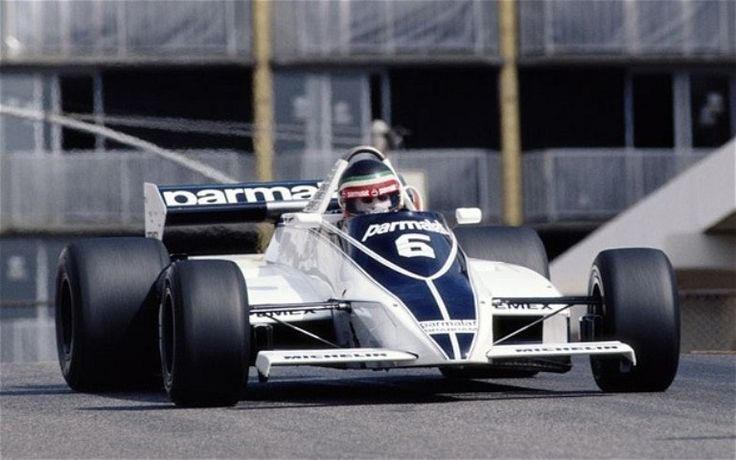1981 Brabham BT49

The descriptions of the Classic Cars in the Directory were partly generated or supplemented with the help of artificial intelligence (AI). The content may occasionally not always be entirely accurate or factually correct despite careful checking.
The Brabham BT49, designed by legendary Formula One designer Gordon Murray, was one of the most successful cars of its era. The 1981 version of the car featured some significant upgrades to its chassis and engine that gave it a real edge over its rivals.
The heart of the BT49 was its turbocharged 1.5-liter Ford-Cosworth DFV V8 engine, which produced around 560 horsepower. This powerplant was mated to a Hewland FGA five-speed gearbox that was operated via a traditional H-pattern shifter. The engine was mounted low and to the rear of the car to optimize weight distribution and minimize the effects of engine torque on handling.
The BT49's chassis was a sophisticated monocoque construction made from aluminum sheet bonded to honeycomb panels. This was a major improvement over the previous year's BT48, which had a more conventional aluminum-tube spaceframe chassis. The monocoque chassis was much stiffer, which helped to improve the car's handling and let Murray make more precise adjustments to the suspension setup.
The suspension on the BT49 was a double-wishbone arrangement at both the front and rear, with inboard spring/damper units and rocker arms. This design allowed the suspension to be more compact and allowed for more precise control over the car's handling. The front suspension was mounted on tall, angled uprights that allowed air to flow cleanly around the front wheels and minimize drag.
One of the most distinctive features of the BT49 was its unique "V-shaped" wing, which was mounted on top of the engine cover. This aerodynamic device was designed to provide downforce to the rear of the car without increasing drag. The wing was adjustable for angle and was capable of generating around 500 pounds of downforce at high speeds.
The BT49's cockpit was a tight squeeze for its drivers, but it was packed with all the necessary instruments and controls. The driver sat low and far forward in the car, with their feet tucked up under the dashboard. They operated the clutch, brake, and accelerator pedals via a lightweight, forged-aluminum pedal box. The steering wheel was a small, unadorned affair with no buttons or display screens, and the gearshift lever sprouted from the top of the transmission tunnel.
Overall, the Brabham BT49 was a beautifully engineered car that demonstrated Murray's keen attention to detail and advanced design concepts. Its combination of power, agility, and aerodynamic efficiency made it a formidable competitor on the racetrack and a favorite among drivers and fans alike.
Milestones
- March 15, 1981: The Brabham BT49 is unveiled and makes its first public appearance at the Brazilian Grand Prix. - April 12, 1981: The BT49 wins its first race at the Argentine Grand Prix with Nelson Piquet behind the wheel. - May 17, 1981: Piquet wins the Monaco Grand Prix in the BT49, solidifying the car's place as a top contender in the championship. - July 5, 1981: Piquet wins the French Grand Prix, giving him a comfortable lead in the drivers' championship standings. - August 9, 1981: Piquet wins the German Grand Prix, extending his lead in the championship and further establishing the BT49 as one of the most dominant cars of the season. - September 27, 1981: Piquet secures the drivers' championship title by finishing third in the Caesars Palace Grand Prix in Las Vegas, driving the BT49. - October 25, 1981: The final race of the season is held in Las Vegas, with Piquet and the BT49 finishing second behind Alain Prost's Renault. The Brabham team ends the 1981 season as constructors' champions.Technical
- The Brabham BT49 was a Formula One racing car designed by Gordon Murray and built by the Brabham team in 1981. - The car featured an aluminum monocoque chassis, with front and rear tubular subframes to attach the suspension and engine. - The engine was a turbocharged Ford Cosworth DFV V8, which produced around 560 horsepower at 10,500 rpm. - The transmission was a Hewland FGA 400 five-speed manual gearbox, with a hydraulic clutch and limited-slip differential. - The suspension was independent all around, with double wishbones, coil springs, and adjustable dampers. - The brakes were ventilated discs with Lockheed calipers, operated by a hydraulic system. - The wheels were made of magnesium alloy and fitted with Michelin tires. - The car had a wheelbase of 2,718 mm (107 in), a length of 4,425 mm (174 in), a width of 2,050 mm (81 in), and a height of 915 mm (36 in). - The fuel tank had a capacity of 195 liters (51.5 US gallons), and the car weighed around 585 kg (1,290 lb) without fuel. - The Brabham BT49 was driven by Nelson Piquet, who won the 1981 FIA Formula One World Championship with three victories and five pole positions.